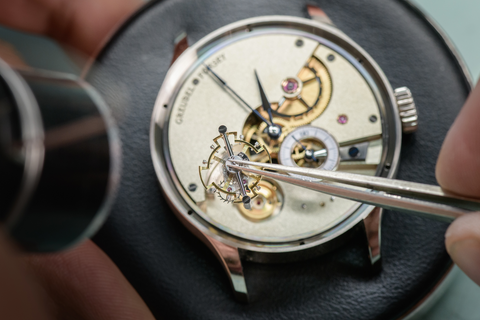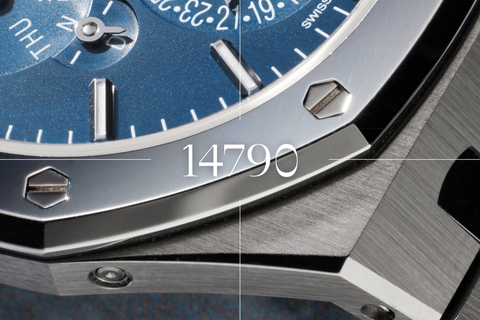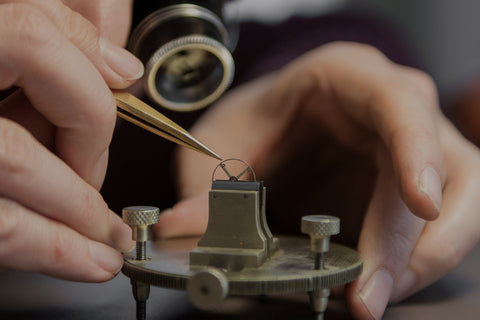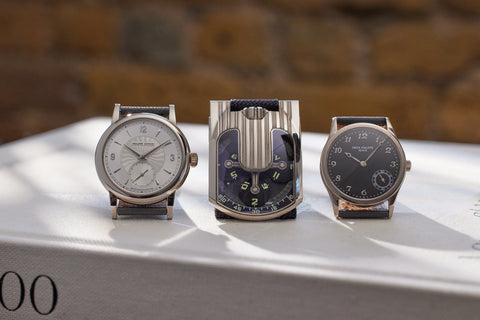This Daniel Roth Monopusher Chronograph is a rarely seen example in yellow gold. Combining a vintage Lemania 2220 movement, beautifully finished dial, and distinctive case design, this piece stands out as one of the most significant creations of Daniel Roth.
Worth Reading
In 1991, only two years after establishing his eponymous brand, Daniel Roth produced a small number of Monopusher Chronographs, limited to only 36 pieces in yellow gold and 16 in platinum. Roth retrieved a small number of Lemania 2220 movements from the ‘30s, which were traditionally used in pocket watches, and refinished them to the high standard which has come to be expected from the watchmaker. Indeed, the relatively large and expansive movement displays sharp Côtes de Genève, subtly bevelled edges, and masterfully polished components. Roth was perhaps one of the first independent watchmakers to integrate high-quality vintage ébauches into his creations, with this tradition later being carried on by the likes of Kari Voutilainen.
Cased in yellow gold, the watch bears a matching dial tone, with silvered chapter rings for the indexes and sub-dials. The varying textures, from the Clous de Paris in the centre to the brushed chapter rings, makes the dial visually intricate and refined. The watch is signed "DANIEL ROTH" at 12 o'clock and "NUMERO X" just below 6 o'clock, in the style of Roth's vintage inspirations. The movement displays the same number, in line with Roth’s practice of numbering dials and movements. The lance-shaped hands, a visual inspiration from the Abraham-Louis Breguet, are rendered in blued steel.
The double-ellipse case of the monopusher is extremely innovative in its execution. Neither round nor rectangular, it balances the two different shapes, complemented by a stepped bezel and sharp, straight lugs. The monopusher on the right-hand side of the case repeats this double-ellipse shape, lending balance to the overall design. Interestingly, the case of this Monopusher Chronograph is larger than the other chronographs produced by Roth during this era, to accommodate for the larger Lemania 2220 ébauche.
Later on, after the watchmaker began to be less involved with the brand, 10 more of these movements were found and installed into Daniel Roth chronographs. These can be distinguished from the first batch of monopushers thanks to their swan-neck regulator, which was not included the first time round, and a less intricate dial design.
Specifications
Closer look
| Brand: | Daniel Roth |
| Model: | Monopusher Chronograph |
| Movement: | manual-winding calibre Lemania 2220 |
| Functions: | hours, minutes, sub-seconds, monopusher chronograph |
| Features: | double-ellipse case, Clous de Paris guilloché dial, blued steel lance hands, display back |
| Case material: | yellow gold |
| Case diameter: | 41mm x 38.5mm |
| Crystal: | sapphire front & back |
| Strap: | bespoke saffiano strap from our own collection, Daniel Roth black alligator strap, Daniel Roth yellow gold pin buckle |
| Lug width: | 21 x 18mm |
| Year: | c. 1991 |
| Accompanying materials: | N/A |
Condition
This Daniel Roth Monopusher chronograph is in excellent condition for a watch of its age, showing some signs of wear throughout though retaining its original case profile. The watch was recently serviced.
Warranty
The watch comes with a two-year warranty from A Collected Man, alongside a lifetime guarantee of authenticity.
We stand by the quality of all of our pre-owned watches and mechanical objects. If something goes wrong, we’ll always strive to remedy the situation in a timely manner and to the best of our ability. The satisfaction and trust of our clients is of the highest importance, to everyone at A Collected Man.
All of our pre-owned watches have undergone thorough, non-invasive mechanical inspections and have been serviced, if appropriate, to ensure that they meet our highest standards of timekeeping and functionality.
Our pre-owned watches, unless stated otherwise, are covered by either a full or a limited twenty-four month warranty. This excludes any damage sustained due to improper use or accident. Due to their age, some pre-owned watches should not be subjected to the same conditions as when new.
Any of our pre-owned watches which have been serviced by their respective manufacturer, will carry the manufacturer’s servicing guarantee. This is separate and supersedes, the standard warranty offered by A Collected Man. Please see our Terms & Conditions for further information. You can write to us directly at enquiries@acollectedman.com, for further clarification.
A Collected Man is also an authorised retailer for a number of watchmaking brands. These watches are covered by the warranty from the original manufacturer.
*Holiday Shipping Dates*
The last day of shipping will officially be Wednesday, 17th December (we may accommodate other requests, on a discretionary basis). The last guaranteed international shipping date shall be Friday, 12th December.
We offer complimentary worldwide delivery on our watches. If ordering from overseas, delivery will depend on the value of the timepiece and the destination. All import taxes, duties and tariffs are the responsibility of the buyer.
If ordering from the UK before 1 PM, your watch will be sent the same working day. The courier will depend on the value of the watch, with all watches delivered the next working day.
Please note that pre-owned goods (in the United Kingdom) are subject to a marginal rate of VAT, which can not be reclaimed. For further information, please see here.
Enquire
Please fill out the details below and we'll be back in touch shortly. Thank you.
Join the List
Get notified as soon as new pieces from this brand are added to our collection.
RISE OF NEO-VINTAGE WATCHES
For a long time, watch collecting was firmly divided into two camps. Vintage and modern. One offered elegant aesthetics, characterful patina, and a romantic attachment to a different vision of watchmaking. The other provided reliability, and the excitement of something which was innovative or cutting edge. Often, when people initially get interested in watches, this early fork in the road, is the one they come across first, but which way should they go?




More recently, a third category has gained prominence – neo-vintage. Neither modern, nor vintage, as the name would imply, it gathers elements from both. From the aesthetics, production techniques, materials, and context in which they were produced, watches that belong to this group are the result of mixed influences. They were long discarded by collectors, precisely because they fell between the cracks. To many, they either lacked the charm of older pieces or the excitement of new releases.
Neo-vintage Watches at A Collected Man

Gérald Genta: Beyond the Royal Oak and Nautilus
By Russell Sheldrake

The Bare Bones Of the Skeletonised Watch
By Josh Sims

Making the Case for Round and Shaped Watches
By Josh Sims

The Tourbillon and why it still matters
By Russell Sheldrake

A Collector’s Guide: Early Daniel Roth
By Russell Sheldrake

A Collector's Guide: Patek Philippe 3800 Nautilus
By Russell Sheldrake

A Collector's Guide: Asymmetrical Watches
By Raj Aditya Chaudhuri

A Collector’s Guide: The Audemars Piguet Royal Oak ref. 14790
By Russell Sheldrake

Is There Still a Divide Between In-House and Ébauche?
By Felix Scholz

Interview: François-Henry Bennahmias CEO of Audemars Piguet
By Russell Sheldrake

What Is Independent Watchmaking?
By A Collected Man

















































































































































































































































































































